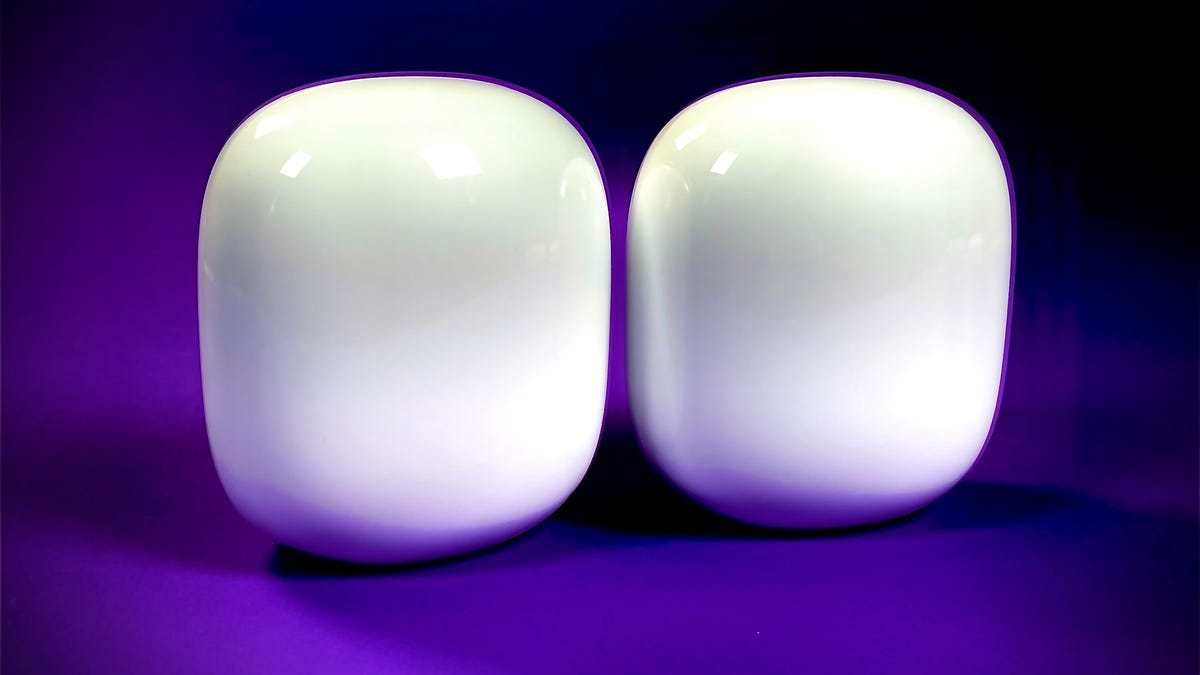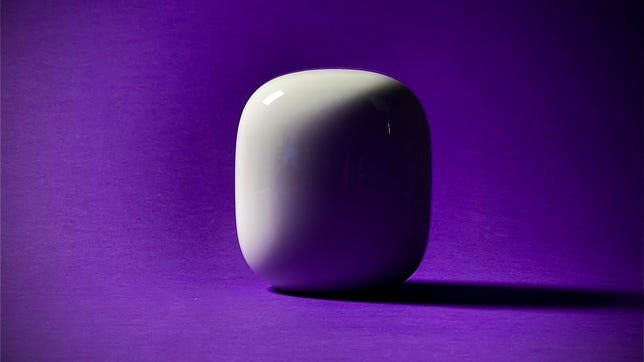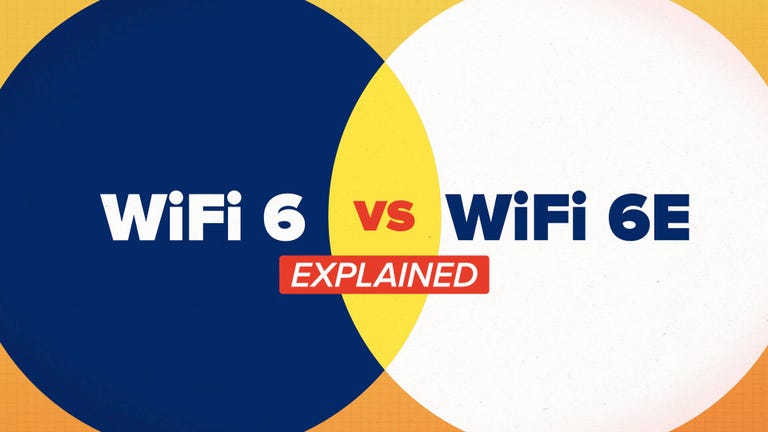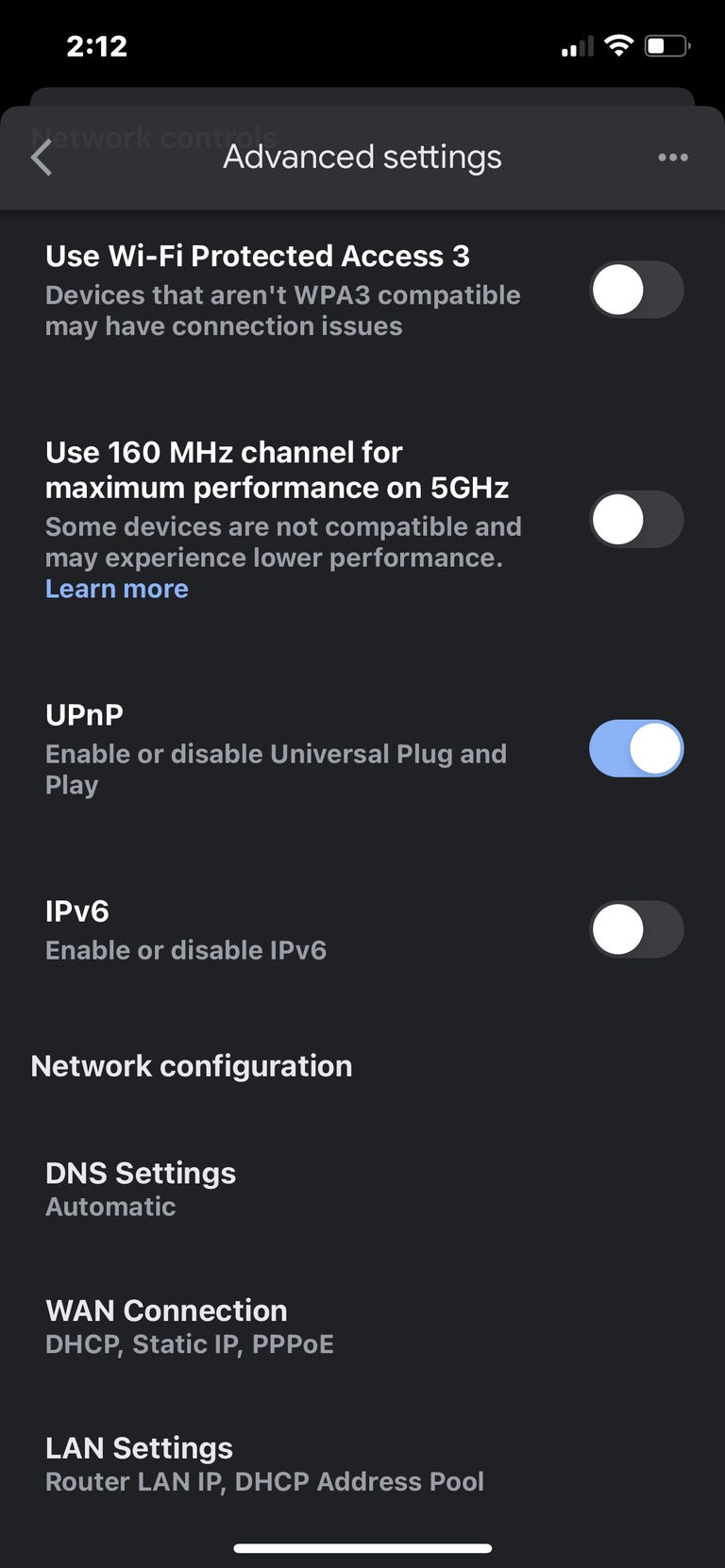Nest WiFi Pro Review: A Wi-Fi 6E Mesh Router Built for Smart Homes








7.7
Nest Wifi Pro
Like
- Highly consistent speeds
- Easy to set up and manage
- Strong smart home support via Google Home app and built-in Thread radio
- Design can blend in just about anywhere
- Excellent value among Wi-Fi 6E mesh routers
Don’t like
- WAN port caps incoming wired speeds from the modem at a single gigabit per second
- Wasn’t fast enough to make full use of a gigabit connection in our wireless speed tests
- Regular latency spikes as high as 150ms
- Support for 160MHz channels on 5GHz band doesn’t work with all devices
Google has been in the router business for a while now, and it was only a matter of time before the company introduced a higher-end machine for pro users. Lo and behold, the Nest Wifi Pro. Google’s upgraded mesh router supports the Wi-Fi 6E standard and smart home essentials like Thread and Matter.
More importantly, the Nest Wifi Pro keeps its distinctive minimalist design that will comfortably slot into most living rooms. Want to add some pizzazz to the marshmallow-like design? You’ll even get a choice of four colors, including a pastel blue dubbed Fog, a beige-like Linen, a pastel-yellow Lemongrass and a white conveniently called Snow.
Even the greatest of designs can’t save an ill-equipped router. Thankfully, that’s not the case here. Each Nest Wifi Pro module promises combined speeds of up to 5.4Gbps across all three of its bands. That’s twice what the original Nest Wifi router promised — a pretty solid upgrade already. Do keep in mind that those are just theoretical maximums. Real-world speeds will be significantly lower as you can connect to only one band at a time.
This brings up the question of whether it’s worth going to Pro. The Nest Wifi Pro’s budget-friendly positioning and ease of access make it a solid alternative to the comparable Eero Pro 6E system. It’s also a fraction of the cost of higher-end routers like the AXE11000 version of the Netgear Orbi.
Look, the Nest Wifi Pro isn’t going to blow you away with top-tier speeds, nor does it offer Pro-essentials like multi-gig WAN — a must for those who have invested in some of the best multi-gig internet plans. It makes up for those misses with steady reliability, ease of setup and exceptional value among Wi-Fi 6E routers. If you’re looking for the absolute best mesh router on the market, the Nest WiFi Pro might not be what you’re looking for.
Design: Nest Wifi Pro brings the color (but forgot the multi-gig jack)

Each Nest Wifi Pro device is identical and interchangeable, with two Ethernet jacks in the back. With the original Nest Wifi, the extenders were separate devices from the main router, and they didn’t include Ethernet jacks at all.
A little over 5 inches tall and a bit more than 3 inches thick, each Nest Wifi Pro device is identical and interchangeable, and all of them feature a pair of Ethernet jacks, so you can wire any of them to your modem and use it as the main router for your network. That’s a big change from the original Nest Wifi, where the extenders were separate devices from the main router of the system. Those extenders (Nest calls them “Points”) didn’t include Ethernet jacks at all, which meant that you couldn’t wire them back to the router for faster performance.
The Nest Wifi Pro fixes that, so wired backhauls are back on the menu. If you’d rather stay wireless, the system will relay web traffic through your home using the 6GHz band, which seems like an appropriate use of that spectrum to me. With enough bandwidth for several 160MHz channels, the 6GHz band is well-equipped to move mass amounts of data, and since the only devices that can access that band are other Wi-Fi 6E devices, it’s largely free from congestion and interference too.

Watch this: Wi-Fi 6 vs. Wi-FI 6E: Here’s the difference in three minutes
The other main point of note about those Ethernet jacks on each device is that both of them cap incoming wired speeds at a single gigabit per second. That’s a bottleneck as far as your Wi-Fi is concerned because you’ll need to use one of those jacks to connect the router to your modem. If you’re paying for a multi-gig internet plan, those faster-than-a-gigabit speeds won’t make it past that bottleneck, so you won’t see Wi-Fi speeds any faster than a single gig.
It’s a head-scratching omission for a couple of reasons. The first is Nest’s “Pro” branding, which positions the system as an upgrade pick. That pitch makes considerably less sense given the growing number of competitors that offer multi-gig WAN ports, including systems from Eero, Asus, Netgear and more. Some of those systems have been on the market for years at this point.
The second reason? Multi-gig internet plans are on the rise, with several new options available this year from names like AT&T, Frontier, Xfinity, Ziply Fiber, Verizon and Google Fiber, which was one of the first to offer a multi-gig plan at 2Gbps, and which recently touted speeds as high as 20Gbps in its latest field tests. If you sign up for a multi-gig internet plan like that from Google, then you’ll want to be sure to use something other than Google’s own top-of-the-line mesh router, because it doesn’t support multi-gig Wi-Fi speeds at all. Again, head-scratching.
App controls: Google Home goes all-in
Getting started with Nest Wifi Pro is easy: just plug one of the devices in and connect it to your modem using an Ethernet cable, then open the Google Home app on your Android or iOS device. An option to set up the new Nest Wifi Pro system immediately appeared right at the top of the app’s home screen. I gave that a tap, followed a few simple instructions and had my network up and running within a few minutes.
Your Nest Wifi settings (that green icon in the top row) will need to compete with lots of other smart home gadgets for your attention in the Google Home app.
With no mish-mash of flashing lights to decipher, no buttons to press, no IP addresses to punch into a web browser and no settings to toggle, it’s really about as simple as router setup gets. That’s a big part of the appeal here — it might be called Pro, but the router is essentially noob-proof.
The biggest advantage here is the robust smart home tech rather than the Wi-Fi management offered by the Nest Wifi Pro. Packing radios for Thread and Matter, Google is positioning the high-end router as the central hub for all your smart home gadgets.
I happen to think it’s a good, cohesive pitch and something to watch as Matter makes its big debut. If not, and smart home tech doesn’t appeal to you, then Nest Wifi Pro and the Google Home app might feel like overkill.
Performance and speed: Nest Wifi Pro vs. its top Wi-Fi 6E mesh competitors
To give the Nest Wifi Pro a fair shake, I pitted it against two of the best Wi-Fi 6E mesh routers around: Amazon’s Eero Pro 6E and the AXE11000 version of the Netgear Orbi. Both of those systems command a premium over the Nest Wifi Pro, but I wanted to see if Google’s Nest could keep up with the two — both with Wi-Fi 6 and Wi-Fi 6E client devices.
Across all rooms tested in a 1,350 square foot test space with a gigabit internet connection, the Nest Wifi Pro’s average download speeds (left) and average upload speeds (right) to a Wi-Fi 6 client device lagged behind the Eero Pro 6E and Netgear Orbi AXE11000 mesh systems — though each of those competitors costs more than Nest Wifi Pro.
Wi-Fi 6 speeds
My Wi-Fi test setup consists of a 1,350-square-foot space with multiple rooms and gigabit fiber internet speeds. With each system’s router set up in the living room and a single extender set up in the kids’ room at the opposite end of the test space, I spent several days measuring average upload and download speeds across four rooms in the space as well as a fifth room several meters away that we’ve designated as the “garage.”
In the end, it was Eero Pro 6E that logged the fastest average speeds to my Wi-Fi 6 test device, a Lenovo ThinkPad laptop that I picked up in late 2019. The Netgear Orbi system was close behind it, followed by the Nest Wifi Pro in a not-too-distant third place. All three kept my speeds in the triple digits in all rooms at all times, which would make for a pretty satisfying internet experience at home. Still, I was disappointed to see Nest Wifi Pro return average upload and download speeds across the whole space that fell below 500Mbps. With Eero Pro 6E, my average Wi-Fi 6 download speed was 586Mbps, with uploads at an even more impressive 720Mbps. With Netgear Orbi, those figures were 566Mbps and 631Mbps, respectively.
Again, those systems are each more expensive than Nest Wifi Pro, so a slight dip in performance seems like a reasonable trade-off so long as the speeds are consistent, reliable and fast enough for everyday activities like streaming, working from home, video conferencing and gaming online. Nest Wifi Pro checks all of those boxes, but it still would have been nice to have seen a little more oomph here.

The AXE11000 version of Netgear Orbi is built to take full advantage of Wi-Fi 6E, complete with two separate 6GHz bands, so it’s no surprise that it returned the fastest average speeds to a Wi-Fi 6E device. And again, Nest Wifi Pro came up short.
Wi-Fi 6E speeds
With Wi-Fi 6 speeds tested, I set the ThinkPad aside and started running tests on a Samsung Galaxy S21 that comes with full support for Wi-Fi 6E. This is the forward-looking part of my tests — will these systems make use of the 6GHz band to deliver noticeably speedier performance to next-gen devices, and if so, how much speedier?
The graph above gives you a sense of how they did. This time around, it was Netgear Orbi that led the way, particularly with upload speeds, where it returned extremely solid average speeds of 800Mbps across the entire area. Eero Pro 6E came in second with average uploads of 591Mbps, and Nest Wifi Pro brought up the rear with a surprisingly low 397Mbps. Nest’s average download speed to my Galaxy device was a little better, coming in at 524Mbps, but that was still behind the 745 and 708Mbps download averages for Netgear and Eero, respectively.
I’d have liked to have seen Nest do a lot better here. That 397Mbps Wi-Fi 6E upload average was even lower than I saw from my Wi-Fi 6 laptop, where the average upload came in at 463Mbps. Then again, the same was true with Eero — the average uploads were faster with my Wi-Fi 6 laptop (720Mbps) than with my Wi-Fi 6E smartphone (591Mbps). Only the Netgear Orbi system was able to boost the uploads on my Wi-Fi 6E device, and that makes sense given that it’s an ultra-fancy, quad-band router with two separate 6GHz bands, one dedicated to the wireless backhaul and another that’s designated for client devices like my Galaxy phone. The Eero and Nest systems are tri-band models that include only a single 6GHz band, and each of them uses that band primarily as the system’s wireless backhaul.
These graphs plot out the latency results for every speed test that we run with each system, all to the same server during the same testing period. The Eero and Netgear systems (blue and red) held latency to approximately 20ms across all tests with no major spikes. The Nest Wifi Pro (yellow) kept latency to around 20 ms during most tests, too — but it also saw several major spikes as high as 150ms. (Note that the scale is much larger with the Nest graph — we had to zoom out to show you how big the spikes were.)
Latency was all over the map…
Latency is something else I keep an eye on in my tests, as it measures the time it takes a router to send a signal to a given server and receive a response. Routers that can hold latency as low as possible are better picks for things like videoconferencing and online gaming, where a half-second delay in your connection could be a major drag.
To test for this, I run all of my speed tests on the same server and log the latency result for every speed test I run. What results are those radar graphs up above — each one shows you each and every latency result for a given router plotted out as a circular line graph. You want to see a ring that’s as smooth and close to the center as possible.
That’s essentially what I got from Eero and Netgear, each of which held latency to a test server roughly 275 miles away to about 20ms across several days of tests. Things were different with Nest Wifi Pro — although latency once again came in at around 20ms for the majority of tests, I also saw regular spikes to 50, 80 or even 150ms, which is why the Nest graph looks more like a kindergartner’s finger painting of the sun. In many cases, you might not even notice spikes like those, but still, it’s less than ideal if you’re in a sudden-death online gaming scenario or if you have a big job interview over Zoom coming up.
Each dot in these graphs is a single download speed test result. Netgear and Nest were both highly consistent as I moved from room to room, but Eero’s living room speeds were much lower during test runs where I started my connection far from the router.
…but on the bright side, speeds were highly consistent
Even if Nest’s speeds were a little slower than I’d like to see in these tests, I was struck by how consistent those speeds were from run to run.
Specifically, I ran three sets of tests on my Wi-Fi 6 device with each system I tested, one during morning hours, one during evening hours, and one during the middle of the day. For each of those sets, I’d run multiple speed tests in each room, starting with the living room and working my way to the garage. Then I’d disconnect and reconnect right there in the garage, the farthest point from the router, and repeat my speed tests backward, ending up where I started in the living room. Splitting my tests into a front-to-back set and a second back-to-front set lets me see if performance differs based on how close you are to the router when your device establishes its connection.
With Nest and Netgear, it made very little difference at all, which is a very good result for a mesh router given that the addition of satellite extenders adds some variability to your connection and the way it’s routed. You can see it in the graphs above, where each dot represents the download speed from a single speed test. Across all tests, the dots in the Netgear and Nest graphs stayed very close together in each room. That tells you that the speeds stayed consistent no matter whether it was morning, noon or night, and no matter whether I started my connection close to the router or far from it.

WPA3 security and 160MHz channel width over 5GHz are two Nest Wifi Pro options that come off by default. Turning the latter on might force some of your devices onto the much-slower 2.4GHz network.
It’s a different story with Eero. Although the Eero Pro 6E logged some of the fastest close-range living room and kitchen speeds that I saw during this round of comparison tests, it also logged some of the slowest speeds in those rooms — and that’s because the system was keeping my traffic routed through the extender during test runs that started in the garage, even after I’d move back into the kitchen and living room. In fairness, that seemed to happen a bit with Netgear and Nest, as well, but it hardly impacted my speeds as it did with Eero. At any rate, it’s typically a very good result when a $299 mesh system can keep up with one that costs $1,000 or more.
160MHz channel support on 5GHz might be a no-go for some
The last thing I’ll note on the performance front is that Nest Wifi Pro supports 160MHz channel width on the 5GHz band. The feature is off by default, as not every device supports it. That includes my Wi-Fi 6 test laptop — as soon as I tried turning it on, my speeds collapsed to 100Mbps or less, even at close range. That’s because it wasn’t connecting over 5GHz at all anymore — without 160MHz support, it had no choice but to move all traffic to the much slower 2.4GHz band.
“This is for devices which support 5GHz and are compatible with the new, high power 160MHz channel,” a Nest spokesperson explained when I asked for clarification about what was going on. “Some 5GHz devices fully support the new 160MHz channel. Some 5GHz devices don’t fully support the new 160MHz channel, but use it as if it were an 80MHz channel. Unfortunately, other 5GHz devices not only don’t fully support the new 160MHz channel, but also don’t use it as if it were an 80MHz channel; these devices connect to a 2.4GHz channel instead.”
Google says that it expects a growing number of devices to come on board with that feature in the coming year and that it’ll consider turning it on by default once enough devices support it. That’ll be something to watch for if you’re using this system.

Is ‘good enough’ good enough for you?
That’s really the question here. Nest Wifi Pro doesn’t offer game-changing Wi-Fi speeds or truly unique features — but it’s a consistent and reliable mesh Wi-Fi system that brings the benefits of the 6GHz band to your home network. Those benefits aren’t going to be that meaningful in many homes at this point, so Wi-Fi 6E isn’t a must-have feature — but with the number of Wi-Fi 6E devices expected to rise steadily in the coming year, it’s still a nice-to-have feature.
With no multi-gig jack and speeds that fall short of other 6E mesh systems we’ve tested, Nest’s “Pro” branding might be a bit much here, so if you’re looking for a true upgrade pick that makes better use of the 6GHz band, you may want to keep shopping around. Along with the aforementioned Netgear Orbi and Eero Pro systems, TP-Link, Linksys and others have Wi-Fi 6E mesh systems that are worth a look. If you’re just looking for a workable, affordable Wi-Fi 6E system that can capably fill your house with a reliable Wi-Fi signal, complete with strong support for the Matter-based smart homes of tomorrow, then Nest Wifi Pro might be exactly what you’ve been waiting for.




